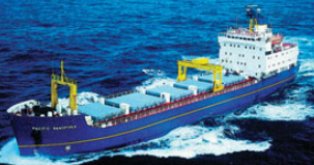Last shipment of vitrified HLW leaves for Japan
13 February 2007
Areva NC has despatched its twelfth and final shipment of vitrified high-level wastes (HLW) from the La Hague reprocessing plant in France to Japan. Six casks holding 130 canisters of HLW are now en route via the Panama canal.
 Since the first shipment in 1995, 1310 canisters containing almost 700 tonnes of HLW have been returned to Japan.
Since the first shipment in 1995, 1310 canisters containing almost 700 tonnes of HLW have been returned to Japan.
The HLW arises from 2940 tonnes of used fuel owned by ten Japanese power utilities, which was shipped by these utilities to France for reprocessing between 1969-90. Some used fuel was shipped to UK also. In the future, reprocessing of Japanese used fuel would be carried out domestically.
The separated HLW has been mixed with molten borosilicate glass and poured into 1.3 m-high stainless steel canisters. The waste becomes locked into the matrix of the glass as it cools, making it stable and resistant to leaching. Lids are then welded on to the canisters to seal them. Each canister contains 150 litres of glass weighing about 400 kilograms. Some 14% of the content is HLW.
The half-tonne stainless steel canisters containing HLW are transported in specially-engineered, heavily shielded steel and resin containers called casks (or flasks). Each weighs about 100 tonnes. A cask holds up to 28 canisters of vitrified waste.
The ships involved are 104 m, 5100 tonne, specially designed double-hulled vessels used only for the transport of nuclear material. They are owned and operated by Pacific Nuclear Transport Ltd, based in UK. This latest shipment is in the Pacific Sandpiper, which left Cherbourg on 8 February and is due in the Japanese port of Mutsu-Ogawa late in March.
Further information
Areva NC
Pacific Nuclear Transport
WNA's Transport of Radioactive Materials information paper